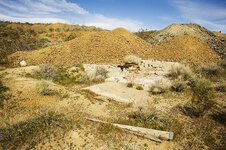jza01701
Full Member
So, I would assume assaying a sample is going to be a common response to this thread.
I have a claim in Nevada that was an abandoned mine.
The tailings near the adit look to be mostly flour gold. The entire pile is filled with golden yellow fine materials.
I was planning on drywashing as there is zero water even to purchase within 30 miles.
I looked at photos of gold dust online; some are likely gold, the rest are likely scammers selling sand.
I was wondering if anyone has ever heard of this or personally pulled large amounts of flour gold out of tailings?
It just seems a little uncommon to me to see such a large amount of gold colored material in the sand and gravel tailings.
Thanks.
I have a claim in Nevada that was an abandoned mine.
The tailings near the adit look to be mostly flour gold. The entire pile is filled with golden yellow fine materials.
I was planning on drywashing as there is zero water even to purchase within 30 miles.
I looked at photos of gold dust online; some are likely gold, the rest are likely scammers selling sand.
I was wondering if anyone has ever heard of this or personally pulled large amounts of flour gold out of tailings?
It just seems a little uncommon to me to see such a large amount of gold colored material in the sand and gravel tailings.
Thanks.
Upvote
0











